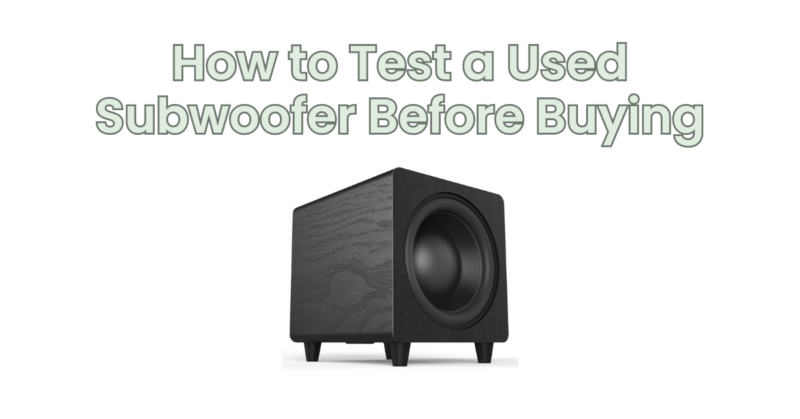Buying a used subwoofer can be a cost-effective way to enhance your audio system, but it’s crucial to ensure that the subwoofer is in good working condition before making a purchase. Testing a used subwoofer allows you to evaluate its performance, sound quality, and overall functionality. In this article, we will provide you with a comprehensive guide on how to test a used subwoofer before buying.
- Visual Inspection: Start by visually inspecting the subwoofer. Look for any visible damage, such as dents, scratches, or cracks on the cabinet, cone, or grille. Pay attention to the condition of the connectors, controls, and any other components. A well-maintained subwoofer will likely indicate proper care by the previous owner.
- Sound Quality: Sound quality is a crucial aspect when evaluating a used subwoofer. Here are the steps to assess the sound quality:
a. Connect the Subwoofer: Set up the subwoofer in an appropriate listening area, preferably in a room where you plan to use it. Connect the subwoofer to a suitable audio source, such as a receiver or amplifier, using the recommended cables.
b. Play Various Audio Tracks: Prepare a selection of audio tracks that cover a wide range of frequencies, including low bass tones. Play different types of music, movies, or test tones that highlight the subwoofer’s performance.
c. Listen for Distortion: Pay close attention to any distortion, rattling, or buzzing sounds during playback, particularly at higher volumes. These issues can indicate problems with the subwoofer’s driver or enclosure.
d. Assess Bass Response: Evaluate the subwoofer’s ability to reproduce low-frequency sounds. Check if it delivers deep, punchy bass without overpowering or muddying other frequencies. Ensure that the bass is tight and well-defined.
e. Test Integration with Speakers: Assess how well the subwoofer integrates with your existing speakers. It should seamlessly blend with the main speakers, providing a cohesive and balanced soundstage.
f. Adjust Controls: Experiment with the subwoofer’s controls, such as volume, crossover frequency, and phase, to optimize its performance in your listening environment. Ensure that these controls are functioning properly.
- Connectivity and Inputs: Verify that all connectivity options and inputs on the subwoofer are working correctly. Test each input and ensure that you can connect the subwoofer to your audio system using different cables and configurations, if applicable.
- Physical Movement and Response: Observe the physical movement of the subwoofer’s driver cone during playback. It should move smoothly and without any restrictions. Excessive cone movement or scraping sounds could indicate a damaged driver or voice coil.
- Documentation and History: If available, inquire about any documentation, such as receipts, service records, or manuals, to gather information about the subwoofer’s history, maintenance, or repairs. This information can provide insights into the subwoofer’s overall condition and care.
- Return Policy and Warranty: Check if the seller offers a return policy or warranty for the used subwoofer. Having a reasonable return period or warranty coverage can provide you with added assurance and protection in case any issues arise after purchase.
- Professional Evaluation: If you lack expertise or are unsure about your assessment, consider seeking assistance from a professional audio technician. They can conduct a more detailed evaluation, perform tests using specialized equipment, and offer expert advice on the subwoofer’s condition.
By following these steps and conducting a thorough evaluation, you can make a more informed decision when purchasing a used subwoofer. Testing the subwoofer’s visual condition, sound quality, connectivity, physical movement, and obtaining relevant documentation will help you assess its overall performance and ensure a satisfying audio experience.
Remember, each subwoofer may have unique characteristics, and personal preference plays a significant role in selecting the right subwoofer for your audio system. Take your time during the testing process and trust your ears to determine if the used subwoofer meets your expectations.


